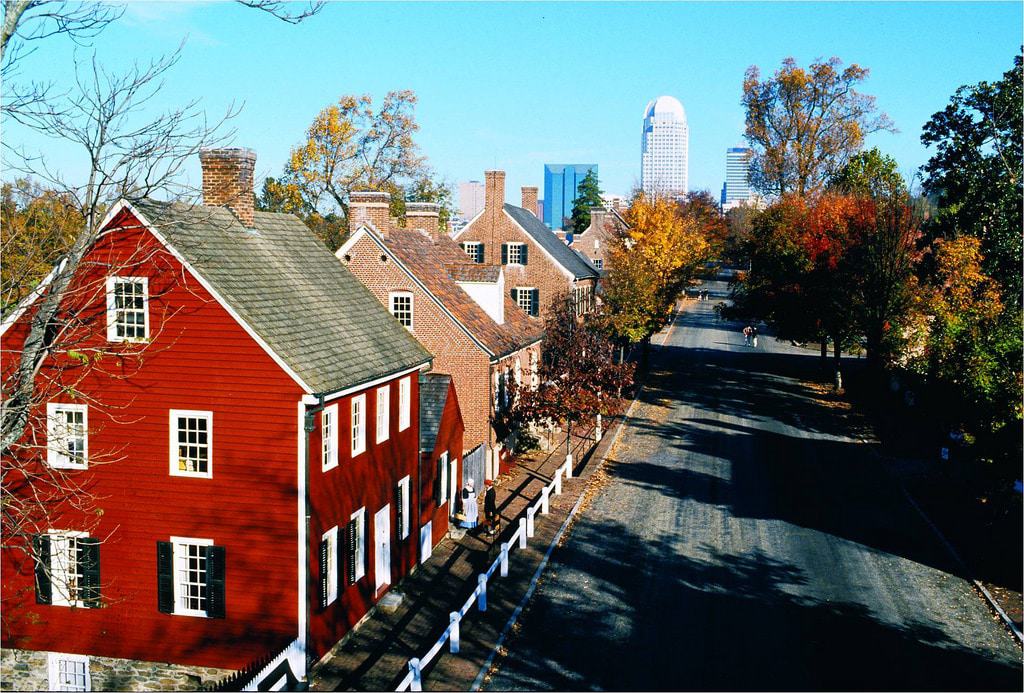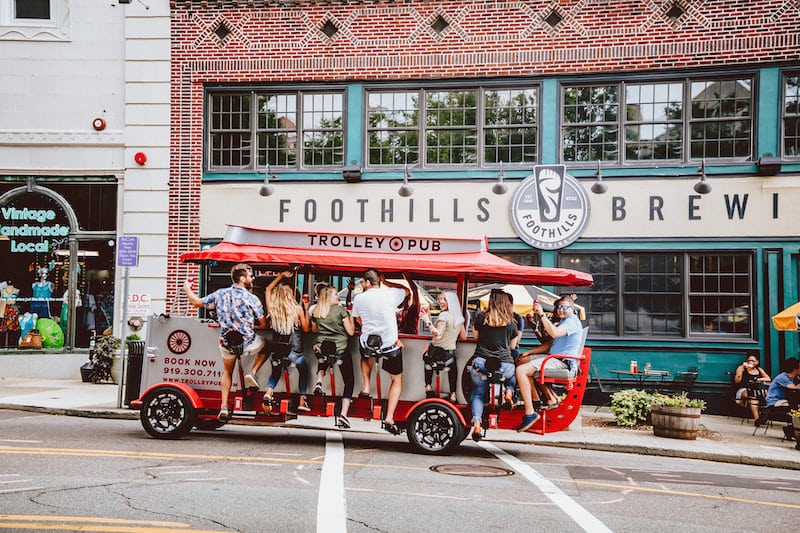HOA Management in Winston-Salem, NC
William Douglas Management is a leader in customer service — the experience and expertise that your association needs and deserves!
Winston-Salem is the county seat of Forsyth County
William Douglas Property Management offers HOA Management and Association Management services in Winston-Salem, NC
The population of Winston-Salem per the 2020 United States Census was 249,545. Winston-Salem is the largest municipality within Forsyth County and the second-largest municipality within the Triad region of Piedmont behind Greensboro. In North Carolina, Winston-Salem is the fifth largest in the state. The major roads and major thoroughfares through and around Winston-Salem: Interstate 40, Interstate 285, Interstate 74, U.S. Highway 421, U.S. Highway 52, U.S. Highway 311, U.S. Highway 158, N.C. Highway 150, and N.C. Highway 67. The annual climate of Winston-Salem is considered moderate.
Winston-Salem offers a vibrant and diverse community, boasting a rich historical tradition, a variety of new and inspired restaurants and breweries, and a walkable downtown filled with a variety of amenities.
Metropolitan Statistical Area or MSA are established by the United States Office of Management and Budget or OMB. A Metropolitan Statistical Area is an urban area with a population of greater than 50,000. A Metropolitan Statistical Area must be comprised of at least one urbanized area. The foundation of Metropolitan Statistical Areas is to calculate similar and related areas, typically counties and cities, into distinct geographic ranges to calculate,
population and to calculate statistical data related to that population. The Winston-Salem Metropolitan Statistical Area population was calculated at 679,948 per the 2020 United States Census. The Winston-Salem Metropolitan Statistical Area encompasses over 2,000 square miles. Five counties comprise the Winston-Salem Metropolitan Statistical Area: Forsyth, Davidson, Stokes, Davie, and Yadkin.
Quick Facts about Winston-Salem
Winston-Salem’s population was calculated as 249,545 per the 2020 United States Census.
Winston-Salem’s population was calculated as 229,617 per the 2010 United States Census.
The first United States Census for Winston-Salem was the 1870 Census, and the population was calculated to be 443.
The largest employer in Winston-Salem is Wake Forest Baptist Medical Center, with around 11,750 employees.
City nicknames: “Twin City” and “Camel City.”
Winston-Salem Motto: “Urbs Condita Adiuvando” Latin translation: City founded on cooperation.
The tallest office building in the region is the Wells Fargo Center at 100 North Main Street at 460-feet and 34 floors.
U.S. News & World Report in 2021 ranked Winston-Salem Number 46 out of 150 cities on the “Best Places to Live” list.
Winston-Salem is the result of the merging of two adjacent towns: Winston and Salem, in 1913.
Per Google Earth, the Coordinates of Winston-Salem are: Latitude: 36°05′59.49″N, Longitude: 80°14′39.18″ W
Brief History of Salem and Surrounding Area
The genesis of what became Salem was established by the Moravian Church in January 1753. Moravian Bishop August Gottlieb Spangenberg chose a tract of land located on the three forks of Muddy Creek. The land totaled just under 99,000 acres and was purchased from John Carteret, the 2nd Earl Granville. The land was part of Carteret’s original share. Carteret’s original share was a 60-mile-wide strip of land abutting the Virginia border that became known as the Granville District.

Many incorrectly believe Lutheranism is the oldest Protestant denomination of Christianity. In fact, the Moravian Church, also known as the Moravian Brethren, predates Lutheranism by sixty years. The Moravian Church dates back to the 15th century and the Bohemian Reformation. The Bohemian Reformation resulted in Unity of the Brethren founded in the Kingdom of Bohemia in 1457, before Martin Luther’s Reformation. Today’s Moravian Church reportedly has over one million members worldwide.
The first settlers to the three forks of Muddy Creek arrived on November 17, 1753. These settlers were to eventually establish the town of Bethabara. Bethabara was never intended to be the primary Moravian settlement. Because of population growth in Bethabara, another settlement was begun in 1759 called Bethania.
As the population kept increasing, another site was selected for a third town. The third town was named Salem. The name Salem is derived from the Hebrew word “Shalom,” meaning “Peace.” The town name Salem comes from a Canaanite city found in the Bible’s Book of Genesis.
The Moravians broke ground on their new Salem settlement on January 6, 1766. The new Salem settlement had a main common square (today Salem Square) with an adjacent house of worship, a Brethren’s House, and a Sisters’ House in 1769 for the unmarried members of the Moravian Church. In 1771, the Moravian cemetery is known as “God’s Acre” is established in Salem. In December of 1856, Salem was incorporated as a town.
Brief History of Winston
Forsyth County was established in 1849 from the lower portion of Stokes County. The county was named for a North Carolina hero of the War of 1812, Colonel Benjamin Forsyth. The Moravian Church sold land north of the town of Salem for a county seat to the newly formed Forsyth County. Until 1851, the new county seat was known as “the county town” or Salem, when the name “Winston” was selected in honor of Joseph Winston, a Revolutionary War hero.
Agricultural played an important role in the development of Winston and the surrounding area, especially the cultivation of tobacco. The first tobacco warehouse in Winston was opened by Major Thomas Jethro Brown in 1868. This first tobacco warehouse was a former livery stable. When the tobacco warehouse opened, Pleasant Henderson Hanes constructed a two-story, forty by sixty tobacco factory close by in 1872. Richard Joshua Reynolds, in 1875 constructed a tobacco factory down the street from Hanes’s factory. Tobacco factories proliferated in Winston, and by the end of the 1880s, there were close to 40 tobacco factories in operation. Wachovia National Bank was first established in Winston in 1879.
Reynolds and Hanes had a tobacco rivalry. Both men continually bought smaller tobacco manufacturers for the next two decades. Their business rivalry only ended when Hanes sold his tobacco operations to Reynolds in 1900. Hanes entered the textile business and had probably more success in that industry.
Winston’s first railroad was the North Carolina Midland Railroad that was incorporated in 1880. The railroad began operation in 1891 after many years of struggling to complete the railroad from Winston to Mooresville. The arrival of the railroad brought economic opportunity to Winston and the surrounding area. Farmers, manufacturers, and merchants had access to new and distant markets. More importantly, they had efficient and economic access to these markets.

In 1896, the population in Salem was around 5,500 and around 13,500 in Winston. While still separate, Winston and Salem were known as Winston-Salem by the U.S. Post Office as early as the 1880s. The Winston-Salem post office was officially established in Winston in 1899, and the old Salem post office was a branch.
After a referendum, the towns were officially incorporated as “Winston-Salem” in 1913. There was some opposition to consolidating the two towns. The opposition rhetoric was considerable, one such rumor being that the consolidated city was going to “dig up God’s Acre,” the Salem Cemetery. The Consolidation Referendum passed and became effective May 9, 1913. The vote totals in Winston were 800 in favor and 260 opposed. In Salem, the vote was 385 in favor and 224 opposed. Seven years later, by the 1920 United States Census, Winston-Salem was the largest city in North Carolina with a population of 48,395, surpassing Charlotte’s population of 46,338 in 1920.
The Reynolds Tobacco Company and the Hanes Textiles Mills continued to be key economic drivers in Winston-Salem into the 20th century. It is estimated that by the 1940s, 60% of Winston-Salem’s workforce was employed by Reynolds Tobacco Company or by Hanes Textiles.
In the early part of the 20th century, Carmel was Reynolds Tobacco Company’s bestselling cigarette product. Reynolds was importing French cigarette paper and Turkish tobacco in such quantities to produce Camels that the United States Customs Services designated Winston-Salem as an official port of entry for the United States. By 1916, Winston-Salem was the eighth-largest port of entry in the United States even though it was, even on today’s Interstate 40 would be over 235 miles to the nearest port. This is quite a remarkable indicator of the volume of commerce within Winston-Salem in the first part of the 20th century.
Into the 20th century, Winston-Salem saw a great deal of growth in population and commerce. The commerce growth propelled Malcolm Purcell McLean to start McLean Trucking Company in 1934 with one used truck. Textiles and tobacco production being so prevalent in Winston-Salem propelled McLean Trucking Company into the second-largest trucking company in the United States.
Vernon Rudolph opened his first Krispy Kreme doughnut shop located on South Main Street in Winston-Salem in 1937. Rudolph began making Krispy Kreme doughnuts and selling them out of his 1936 Pontiac with a delivery rack in the back seat before opening his shop. Krispy Kreme locations are found around the nation and worldwide today.
In 1948 the Camel City Flying Service became Piedmont Airlines. The new airline was based at Winston-Salem’s Smith Reynolds Airport. Piedmont Airlines excelled through the next five decades to become a top-tier airline and was purchased by USAir in 1987. Later USAir became US Airways and merged with American Airlines in 2015.
Today, the economy of Winston-Salem in the last 50 years is much more diverse than it has been at any other time since its founding. While traditionally, textiles and tobacco industries have dominated the Winston-Salem economy, technology has transformed the city and region into a leader in the nanotech, high-tech, and biotech areas. Medical research and technologies are the fast-growing local industry. Wake Forest Baptist Medical Center is the largest employer in Winston-Salem. The city is home to the corporate headquarters of major corporations such as HanesBrands, Inc., Krispy Kreme Doughnuts, Inc., Lowes Foods Stores, ISP Sports, Reynolds American (parent of R. J. Reynolds Tobacco Company), Reynolda Manufacturing Solutions, K&W Cafeterias, TW Garner Food Company, and Blue Rhino.

Although traditionally associated with the textile and tobacco industries, Winston-Salem is transforming itself into a leader in the nanotech, high-tech, and biotech fields. Medical research is a fast-growing local industry, and Wake Forest Baptist Medical Center is the largest employer in Winston-Salem. In December 2004, the city entered into a deal with Dell, providing millions of dollars in incentives to build a computer assembly plant nearby in southeastern Forsyth County.
Four Year Colleges and Universities in Winston-Salem
Winston-Salem State University: Simon Green Atkins founded Slater Industrial Academy on September 28, 1892. The initial Slater Industrial Academy was a one-room frame structure with twenty-five students and a single instructor. Slater Industrial Academy later became Winston-Salem State University.
The North Carolina General Assembly in 1925 recognized Slater Industrial Academy’s advanced curriculum and changed the name to Winston-Salem Teachers College. With this recognition and accreditation, the college was empowered under the authority of the State Board of Education to bestow appropriate degrees. Winston-Salem Teachers College became the first black institution in the United States to bestow degrees for teaching elementary grade school.
A School of Nursing was established in 1953. Because of the expanding curriculum, the North Carolina General Assembly changed the name of the college to Winston-Salem State College in 1963. In 1969, a statute changing Winston-Salem State College as Winston-Salem State University was passed in the legislature. Winston-Salem State University became one of the 16 constituent institutions of the University of North Carolina system, subject to the control of a Board of Governors in 1972.
Wake Forest University: Wake Forest University is a private university founded by the Baptist State Convention of North Carolina in 1834. The university’s name is derived from its original location of Wake Forest, North Carolina, which is a northern suburb of Raleigh. The student body is just over 8,500 students, with an academic staff of just over 6,000. Wake Forest has a broad curriculum. The sports program is NCAA Division I. The university athletic teams are known as the “Demon Deacons” and compete in 16 NCAA Division I intercollegiate sports. Wake Forest is also a founding member of the Atlantic Coast Conference (ACC).
Salem College: Salem College is a private liberal arts women’s college founded in 1772. Originally founded as a primary school, it later became an academy or high school. Eventually becoming a college. Salem College is the oldest female educational institution that is still exclusively a women’s college and the oldest women’s college in the southern United States.
Salem College is located in the historic Moravian section of Winston-Salem. The Little Girls’ School was founded on April 22, 1772. The first teacher was Sister Elisabeth Oesterlein. The girls’ school was initially led by the Single Sisters, the unmarried women of the Moravian community. The Single Sisters cohabitated and were self-sufficient, which was uncommon for women in the eighteenth century. In 1802, it became a boarding school. In 1866, the school changed its name to the Salem Female Academy. The Salem Female Academy began bestowing college degrees in 1890. The school’s name was officially changed to Salem Academy and College in 1907. Constructed in 1785, the Single Sisters’ House is the oldest building on Salem’s campus and one of the oldest in Winston-Salem.
The University of North Carolina School of the Arts: The University of North Carolina School of the Arts bestows high school, undergraduate, and graduate degrees. Founded in 1963, it was the first public arts conservatory in the United States. The student body is comprised of just over 1,100 students, with around 180 academic instructors.
Need Association Management?
Contact Us
How to Start
The Process of Working With Us


REQUEST A PROPOSAL
Request a proposal online or call us directly.


WE WILL REVIEW YOUR CASE
Our team of highly trained professionals will review your case.


RECEIVE A CUSTOM TAILORED PLAN
We will create a customized management plan for your community.


SEAMLESS TRANSITION
We will implement a seamless management transition and integrate our tech.


SIT BACK & RELAX
Enjoy better, affordable and a more reliable, hassle-free management system.




